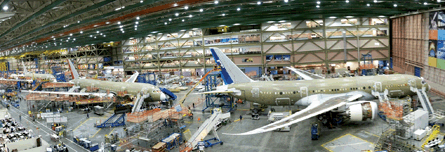Long before production breakdowns and design glitches consumed Boeing's 787 programme, a sudden and chronic shortage of fasteners seemed the next-generation airliner's biggest schedule concern.
Widespread shortages of specially designed bolts, rivets and nut-plates needed to fasten the 787's all-composite fuselage ranked among the two chief problems that Boeing blamed for the initial delay in September 2007.
The 787 fastener shortage three years ago appeared to be as severe as it was unexpected. Although only 3% of the airframe's value, fasteners quickly rose to the top of the programme's priorities.
Boeing management determined the fastener shortage sprang from unusual market and organisational forces within the supply chain.
The response called for systematically changing not only the way Boeing monitors the demand and supply of fasteners, but also the contractual relationship between buyers and sellers.
 |
|---|
© Jon Ostrower/FlightglobalShortages of bolts, rivets and nut-plates needed to fasten the all-composite fuselage contributed to 787 delays |
Three years later, the first goal to reform the 787 programme's system for forecasting supply and demand has been accomplished, John Byrne, Boeing's director of common commodities and raw materials, says.
However, as a new case study published by 787 programme insiders at the University of Michigan makes clear, the broader goal to structurally change the business relationships in the fastener supply chain remain unresolved, fuelling concerns that a fastener shortage could return.
"I think they have a window to get it done," says Ravi Anupindi, professor of operation and management science at the university's Ross School of Business. "It's a do-able proposition and [Boeing managers] realise this."
As the shortage became apparent in 2007, Boeing reached out to Anupindi's graduate students to serve as consultants. From their experience inside the 787 programme, the students worked with Anupindi to produce an academic case study, which was published in November. For its part, Boeing approved of the project and supported the team's research.
"The case study is a good way to document what happened and some of the lessons learned," Byrne says.
The study traced how the 787 fastener shortage began with consolidation in the fastener industry after 11 September 2001, leaving only three companies left at the bottom of the market crash in the early half of the decade. Even as aircraft sales began climbing after 2004, the fastener industry resisted boosting capacity, Anupindi says.
The composition of the streamlined fastener supply chain confused the demand signal. The 18-month delay of the A380 created a "slack" period for demand. Even as Boeing, Airbus and business jet manufacturers climbed to peak rates by 2007, fastener companies failed to keep pace with demand. Meanwhile, parts distributors moved to capitalise on a super-heated market, speculating that loading up on bulk orders of fasteners would pay off.
Finally, even as Boeing struggled to release designs for new 787 parts, rising demand in Asia for raw materials lengthened lead times for fasteners from one to two years. As a result, Boeing's partners building major structures for the 787 began competing with each other for scarce fastener inventories. Unlike for raw materials, Boeing had not moved to aggregate demand with a single bulk order for fasteners.
By mid-2007, Boeing managers recognised that systemic change would be required to restore the health of the fastener supply chain.
Boeing first overhauled the way it kept track of the 787's fastener inventories across the programme's suppliers. For the first time, Boeing implemented a system that could track fasteners "almost by part numbers" across its supply chain, Byrne says.
The system also keeps track of supplier capacity, and adjusts re-order points as lead times changed for the fastener manufacturers. That system is now operational, and should prevent the kinds of parts shortages experienced in 2007, Byrne says.
Boeing also benefits from the dramatic swing in the aviation market, with fastener orders from the general aviation industry, including business jets, plunging since reaching peak in 2008, Byrne says.
More broadly, however, Boeing also wants to make the fastener supply chain more efficient by placing a single contract with fastener suppliers based on the 787's aggregate demand. Boeing's initial proposal to re-order the supply chain in this way met with failure not only with fastener suppliers, but even because of scepticism within the 787 programme, Anupindi says.
Boeing is now "looking at significantly improving our original proposal," Byrne says. Its so-called fastener procurement model "has gone another stage of evolution", he says.
The new proposal is aimed at aggregating demand for fasteners on a single contract. "How you execute that to the supply chain, there's a lot of different ways to do it," he says.
But Anupindi is sceptical that improving the efficiency of the supply chain is a worthwhile goal. Since fasteners represent such a small portion of the 787's cost, disrupting the supply chain could outweigh the gains from even a large improvement in efficiency, he says.
Source: Flight International























